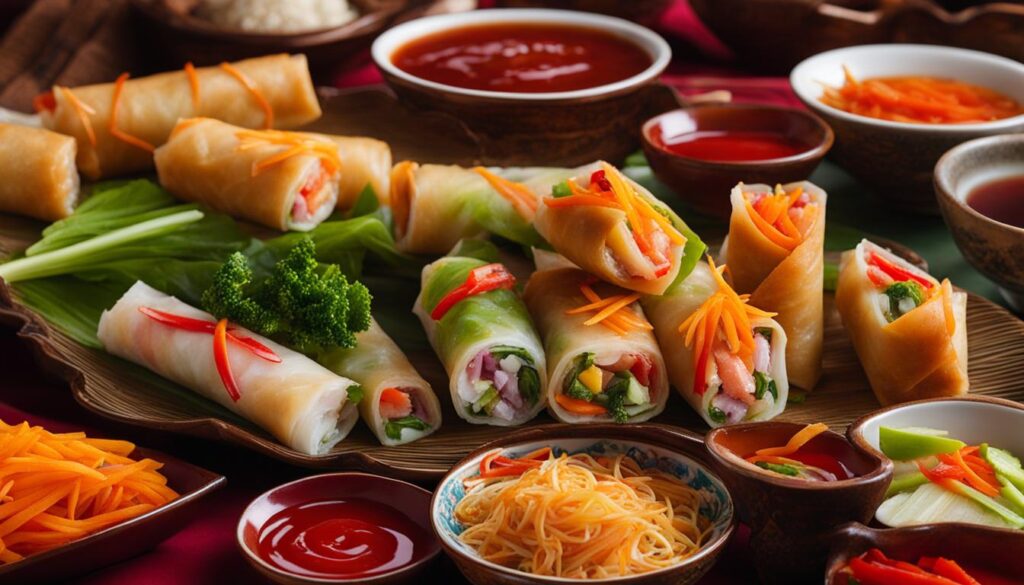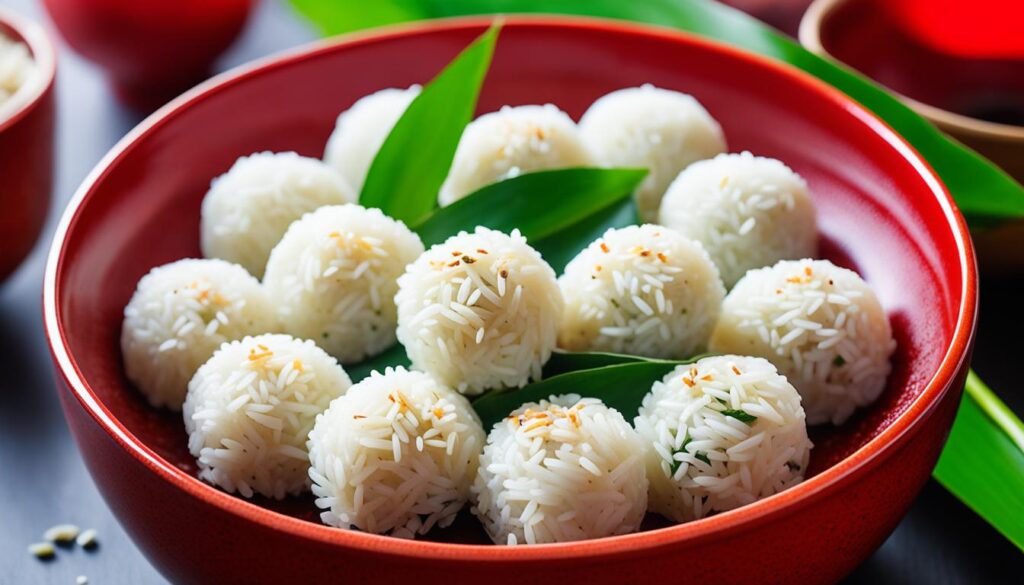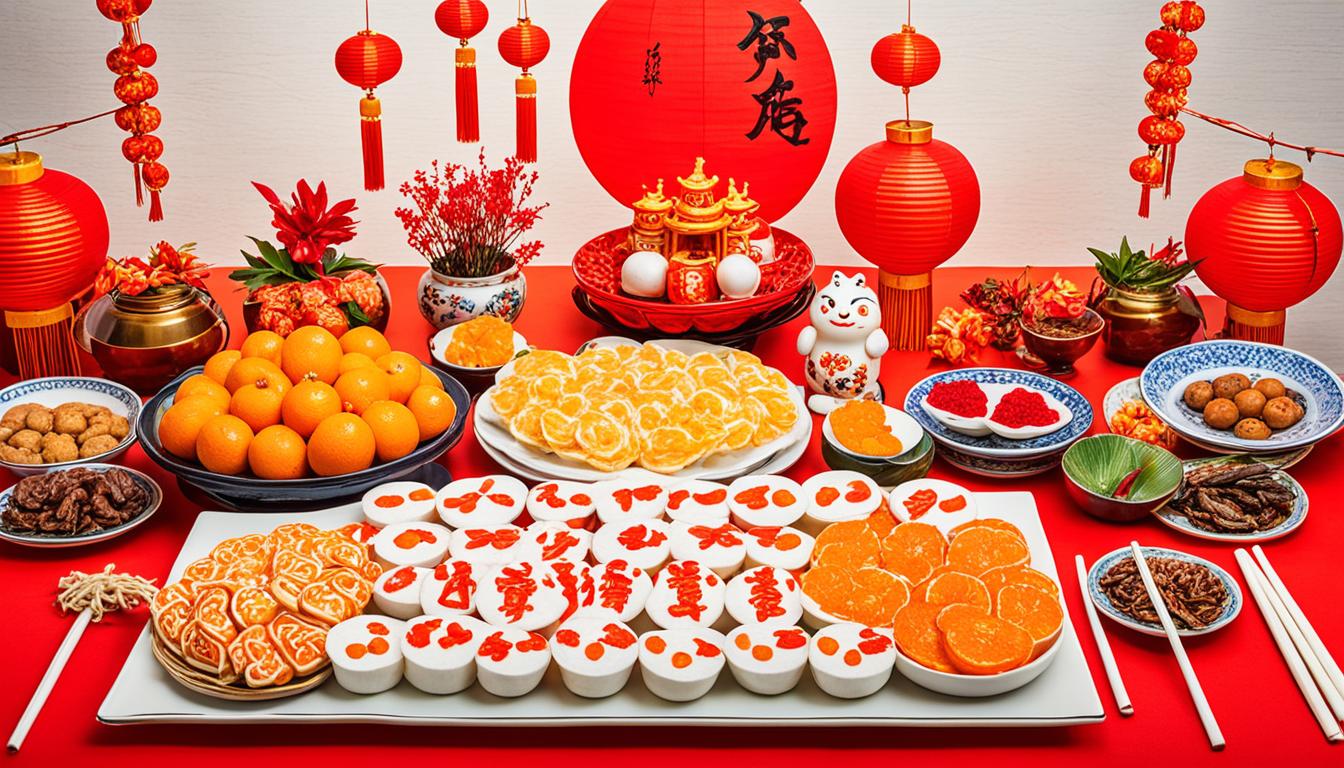Have you ever wondered why certain foods are considered lucky during the lunar Chinese New Year? What is the significance of these traditional dishes and how do they bring prosperity and good fortune? Join us on a culinary journey as we explore the auspicious lunar new year dishes and uncover the symbolic meanings behind them.
Key Takeaways:
- Traditional lunar Chinese New Year foods play an important role in bringing luck and prosperity for the year ahead.
- Dumplings symbolize wealth and good fortune, with the number of dumplings eaten believed to predict financial success.
- Eating a whole fish during the lunar Chinese New Year signifies abundance and prosperity.
- Preserved meats symbolize tradition and preservation, reflecting ancient sacrifices made before the Lunar New Year.
- Spring rolls resemble bars of gold and represent wealth and prosperity.
Dumplings: Symbol of Wealth and Good Fortune
Dumplings are a staple dish during the lunar Chinese New Year. They symbolize wealth and good fortune. The number of dumplings eaten is believed to predict the amount of money one will make in the upcoming year. The fillings of dumplings can vary, including pork, shrimp, chicken, or vegetables. Making and eating dumplings is a traditional practice shared by Chinese families around the world.
To fully appreciate the symbolic significance of dumplings, it is important to understand their cultural and historical context. Dumplings have been a part of Chinese cuisine for centuries and are deeply ingrained in Chinese culture.
The round shape of dumplings is said to resemble ancient Chinese currency, symbolizing wealth and prosperity. In addition, the act of making dumplings is often a communal activity that brings family and friends together, fostering togetherness and unity.
The fillings of dumplings can also hold symbolic meanings. For example, pork dumplings are believed to bring good luck and abundance, while shrimp dumplings are associated with happiness and longevity. Vegetarian dumplings, stuffed with a combination of vegetables and tofu, represent harmony and balance.
During the lunar Chinese New Year, families typically gather around the kitchen table to prepare and eat dumplings together. This tradition not only honors the significance of the dumplings but also strengthens family bonds. The process of making dumplings involves carefully folding and pleating the dough, which requires skill and concentration. It is believed that the more intricate the dumpling folding, the more luck and good fortune it will bring.
“Dumplings are more than just a delicious food; they carry deep cultural and symbolic meanings. They are a way for us to connect with our heritage and pass down traditions to future generations.”
Whether steamed, boiled, or pan-fried, dumplings are enjoyed by many during the lunar Chinese New Year. They are often accompanied by a dipping sauce made from soy sauce, vinegar, and chili oil, adding a burst of flavor to each bite.
The Symbolic Significance of Dumplings:
- Representation of wealth and prosperity
- Prediction of financial fortune in the coming year
- Symbol of communal togetherness and unity
- Various fillings representing different blessings and wishes
- Strengthening of family bonds through the process of making and sharing dumplings
Whole Fish: Symbol of Abundance and Prosperity
Eating a whole fish during the Lunar Chinese New Year is believed to bring abundance and prosperity. In Chinese culture, the phrase “you yu” sounds similar to the phrase “surplus,” signifying the wish for a surplus of wealth and good fortune in the coming year. Various fish preparations are enjoyed during this time, such as steamed fish with vinegar sauce or deep-fried whole fish.
Whole fish holds significant symbolism during the lunar Chinese New Year. It represents completeness, unity, and the potential for a prosperous year. The tradition of serving a whole fish signifies a wish for abundance and the presence of surplus in all aspects of life.
The lunar Chinese New Year fish preparations are diverse and flavorful. Steamed fish with vinegar sauce is a popular choice, known for its delicate and moist flesh. The fish is typically seasoned with ginger, garlic, and soy sauce, then steamed to perfection. The tangy vinegar sauce adds a refreshing element to the dish.
Another favorite preparation is deep-fried whole fish, which results in a crispy and savory delight. The fish is coated in a light batter, seasoned with herbs and spices, and fried until golden brown. The result is a flavorful fish with a satisfying crunch.
Families gather around the table during the Lunar Chinese New Year to enjoy the whole fish dish together, emphasizing unity, harmony, and good fortune for the upcoming year. It is customary to present the fish with the head facing the eldest or most respected member of the family as a sign of respect and gratitude.
Popular Fish Preparations for Lunar Chinese New Year
| Fish Preparation | Description |
|---|---|
| Steamed Fish with Vinegar Sauce | A delicate and moist fish dish seasoned with ginger, garlic, and soy sauce, then steamed to perfection. Served with a tangy vinegar sauce. |
| Deep-Fried Whole Fish | A crispy and savory dish made by coating the fish in a light batter, seasoned with herbs and spices, and fried until golden brown. |
| Fish in Sweet and Sour Sauce | A flavorful fish dish cooked in a sweet and sour sauce, incorporating ingredients like pineapple, peppers, and onions for a balance of flavors. |
Preserved Meats: Symbol of Tradition and Preservation
Preserved meats hold a special place in the culinary traditions of Chinese New Year celebrations. With deep roots in the ancient sacrifices made in the days leading up to the Lunar New Year, preserved meats continue to be a cherished part of the festive menu. These meats, which are often salt-cured, air-dried, and meticulously prepared, represent the values of tradition and preservation.
During Chinese New Year, families take great care in selecting and preparing preserved meats such as salted pork, preserved duck and chicken, and rich sausages. These meats undergo a lengthy process of seasoning, air-drying, and aging, resulting in intense flavors and tender textures that are highly prized. They are typically served as cold dishes, reminiscent of a charcuterie plate, and offer a feast for the senses.
The art of meat preservation in Chinese cuisine is a testament to the resourcefulness and ingenuity of our ancestors, who developed techniques to extend the shelf life of food in the absence of modern refrigeration. Meat-drying techniques, salt-curing methods, and smoking traditions ensured that valuable food supplies would be available throughout the year, even during times of scarcity.
Preserved meats are not only esteemed for their delicious taste and unique textures but also for their cultural significance. They represent our connection to the past and the preservation of culinary traditions. By enjoying these delicacies during Chinese New Year, we pay homage to our heritage and honor the values of tradition, resilience, and sustainability.

The Significance of Preserved Meats
“Preserved meats are more than just food; they are a symbol of our cultural heritage, passed down from generation to generation. They remind us to cherish traditions and preserve our culinary legacy.”
– Renowned Chinese chef, Li Mei
Preserved Meats on the Lunar Chinese New Year Menu
When it comes to celebrating Chinese New Year, preserved meats are a must-have on the festive menu. These flavorful delicacies are often incorporated into various dishes and enjoyed in different ways. Here are some popular preserved meat preparations during the Lunar New Year:
| Preserved Meat | Preparation |
|---|---|
| Salted Pork | Sliced and served as a cold dish or stir-fried with vegetables. |
| Preserved Duck and Chicken | Sliced and served as a cold dish or used in stir-fried rice or noodle dishes. |
| Rich Sausages | Sliced and served as a cold appetizer or cooked with sticky rice for a savory treat. |
These preserved meat dishes provide a delightful contrast to other festive delicacies, adding depth of flavor and a touch of nostalgia to the Lunar New Year feast.
As we gather with loved ones to celebrate the Lunar Chinese New Year, let us savor the preserved meats that symbolize tradition, preservation, and the resilience of our culture. From the careful craftsmanship behind their preparation to the rich flavors they offer, preserved meats honor our culinary heritage and serve as a reminder of the importance of preserving our cultural traditions.
Spring Rolls: Symbol of Wealth and Prosperity
During the lunar Chinese New Year festivities, spring rolls take center stage as a symbol of wealth and prosperity. These delectable treats, resembling bars of gold, are believed to bring good fortune and abundance to those who indulge in them.
The significance of spring rolls lies not only in their appearance but also in the ingredients used to make them. Traditionally, spring rolls are filled with a combination of pork, bean sprouts, shredded carrots, and cabbage. These fillings represent wealth and prosperity, as each ingredient carries its own auspicious meaning in Chinese culture.
To prepare spring rolls, the fillings are carefully wrapped in thin, translucent rice paper before being deep-fried to a delightful crispiness. The golden color of the rolls further enhances their symbolism, resembling the precious metal associated with prosperity and good luck.

Spring rolls are commonly enjoyed as an appetizer or snack during Chinese New Year gatherings. Their crispy texture and savory flavors make them a favorite among both young and old. As families come together to celebrate, sharing spring rolls signifies a collective wish for wealth and abundance to manifest in the coming year.
Whether it’s the symbolism behind their shape, the auspicious fillings, or the joyful act of sharing, spring rolls hold a special place in the hearts and palates of those celebrating the lunar Chinese New Year. By savoring these crunchy delights, we embrace the hopes and aspirations for wealth and prosperity that the new year brings.
Sweet Rice Balls: Symbol of Togetherness and Family Reunion
Sweet rice balls, also known as tang yuan, are a traditional Chinese New Year food that symbolizes family togetherness and reunion. These gummy rice balls are typically served in a sweet, syrupy soup and can be plain or filled with sweet black sesame paste. Eating tang yuan represents a desire for unity and harmony within the family.
During the Chinese New Year celebrations, making and eating sweet rice balls is a common tradition that brings family members together. The process of preparing the rice balls involves a collective effort, as everyone gathers in the kitchen to roll and shape the dough. This activity fosters an atmosphere of warmth, joy, and closeness, as family members share stories, laughter, and create lasting memories.
The round shape of the sweet rice balls symbolizes completeness and unity. It represents the coming together of family members from near and far, as they celebrate the Lunar New Year in each other’s company. The act of eating tang yuan during this festive period signifies the importance of cherishing family ties and the hope for a harmonious and prosperous year ahead.
Just as the sweet rice balls are soft and sticky, binding the ingredients together, so too does it bind our family together. It is a symbol of our love and unity, reminding us of the importance of coming together during this auspicious time.

Preparations and Fillings for Sweet Rice Balls
Preparations for sweet rice balls begin with making a soft and stretchy dough using glutinous rice flour mixed with water. The dough is then divided into small portions, which are rolled into balls. To add a touch of sweetness, some families prefer to fill the rice balls with sweet black sesame paste.
Here are some popular fillings for sweet rice balls:
- Sweet black sesame paste
- Peanut butter
- Red bean paste
- Lotus seed paste
- Crushed peanuts
| Fillings | Description |
|---|---|
| Sweet black sesame paste | A rich and sweet filling made from roasted black sesame seeds. |
| Peanut butter | A creamy and nutty filling that adds a delightful flavor to the rice balls. |
| Red bean paste | A traditional filling made from cooked and mashed adzuki beans. |
| Lotus seed paste | A smooth and fragrant filling made from ground lotus seeds. |
| Crushed peanuts | A crunchy and aromatic filling that adds texture to the rice balls. |
Once the rice balls are formed and filled, they are cooked in boiling water until they float to the surface. They are then transferred to a bowl of sweet syrupy soup, which can be flavored with ingredients such as ginger, rock sugar, and pandan leaves. The soft and chewy texture of the rice balls combined with the sweet soup creates a delightful treat that is enjoyed by all.
Whether plain or filled, tang yuan brings a sense of joy and togetherness during the Chinese New Year festivities. It serves as a reminder of the importance of family and the significance of coming together to celebrate and strengthen the bonds that hold us close.
Longevity Noodles: Symbol of Happiness and Long Life
Longevity noodles, known as changshou mian, are a staple dish during the lunar Chinese New Year. These long noodles symbolize happiness and long life. They are usually served fried or in a simple broth and are believed to bring good luck and blessings for the year ahead.
In Chinese culture, noodles represent longevity and are often eaten during festive occasions. The length of the noodles symbolizes a long and fulfilling life. It is customary to serve the noodles uncut to preserve their symbolism.
“The Lunar New Year celebration is a time when families come together to celebrate and wish each other good fortune and happiness for the upcoming year. Longevity noodles are a dish that embodies these wishes for a long and prosperous life. By enjoying a plate of longevity noodles, we hope to bring joy and good luck to ourselves and our loved ones.”
Preparations for longevity noodles can vary depending on regional traditions. Some popular recipes include:
- Stir-fried Longevity Noodles with Vegetables: This dish combines the noodles with a medley of colorful vegetables for a balanced and nutritious meal.
- Longevity Noodle Soup: A comforting broth-based dish featuring the noodles, along with vegetables, meat, and flavorful seasonings.
- Noodles with Seafood: A delicious combination of fresh seafood, such as shrimp, scallops, and squid, stir-fried with the noodles for a savory treat.
Whether enjoyed as a simple stir-fry or in a flavorful broth, longevity noodles are a must-have dish during Lunar Chinese New Year festivities. Their symbolic meaning of happiness and long life adds a special touch to the celebration, bringing good fortune to all who partake.
Longevity Noodle Recipes for Lunar New Year
| Recipe | Description |
|---|---|
| Stir-fried Longevity Noodles with Vegetables | A colorful and nutritious dish combining longevity noodles with a variety of fresh vegetables, stir-fried to perfection. |
| Longevity Noodle Soup | A comforting and flavorful broth-based dish featuring longevity noodles, vegetables, meat, and aromatic seasonings. |
| Noodles with Seafood | A delectable combination of longevity noodles and a medley of fresh seafood, creating a savory and satisfying meal. |
Fruits: Symbol of Prosperity and Good Fortune
Fruits hold great symbolic significance during the lunar Chinese New Year. Oranges, tangerines, kumquats, and pomelos are among the most auspicious fruits gifted and enjoyed during this festive season. Their round shape and golden color are believed to represent prosperity and good fortune.
The tradition of giving and receiving these fruits stems from their symbolic meanings. Oranges and tangerines are associated with wealth, while kumquats symbolize abundance. Pomelos, with their large size, are believed to bring prosperity and luck.
These auspicious fruits are often placed in prominent locations in homes and businesses to attract positive energy and blessings. They are also commonly given as gifts to relatives, friends, and colleagues as a gesture of well-wishes for the new year.
In addition to their symbolic significance, these fruits are enjoyed for their refreshing taste and nutritional value. The vibrant colors, sweet aroma, and juicy texture of citrus fruits add to the festive atmosphere of Lunar New Year celebrations.
During the festive meals, these fruits can also be incorporated into various dishes and desserts to further enhance the symbolic meaning and overall enjoyment of the feast.
Conclusion
The lunar Chinese New Year is a time of celebration, filled with cultural food traditions and symbolic meanings. Through the selection of lucky foods and auspicious dishes, we can invite prosperity and good fortune into our lives for the year ahead. Each food item, from dumplings to whole fish, carries its own significance, reflecting the rich heritage of Chinese cuisine.
By incorporating these traditional lunar Chinese New Year foods into our celebrations, we not only honor the customs of our ancestors but also create a meaningful culinary experience for ourselves and our loved ones. Whether it’s enjoying the symbolic wealth and fortune represented by dumplings, savoring the abundance and prosperity linked to whole fish, or relishing the togetherness and family reunion symbolized by sweet rice balls, these dishes bring joy and happiness to our festivities.
As we gather around the table during the lunar Chinese New Year, let us remember the deeper meanings behind these cultural food traditions. By embracing the symbolic food meanings and sharing in the tradition of auspicious dishes, we can connect with our heritage and foster a sense of unity and harmony. May these lunar Chinese New Year lucky foods bring blessings and good luck to us all throughout the year.
